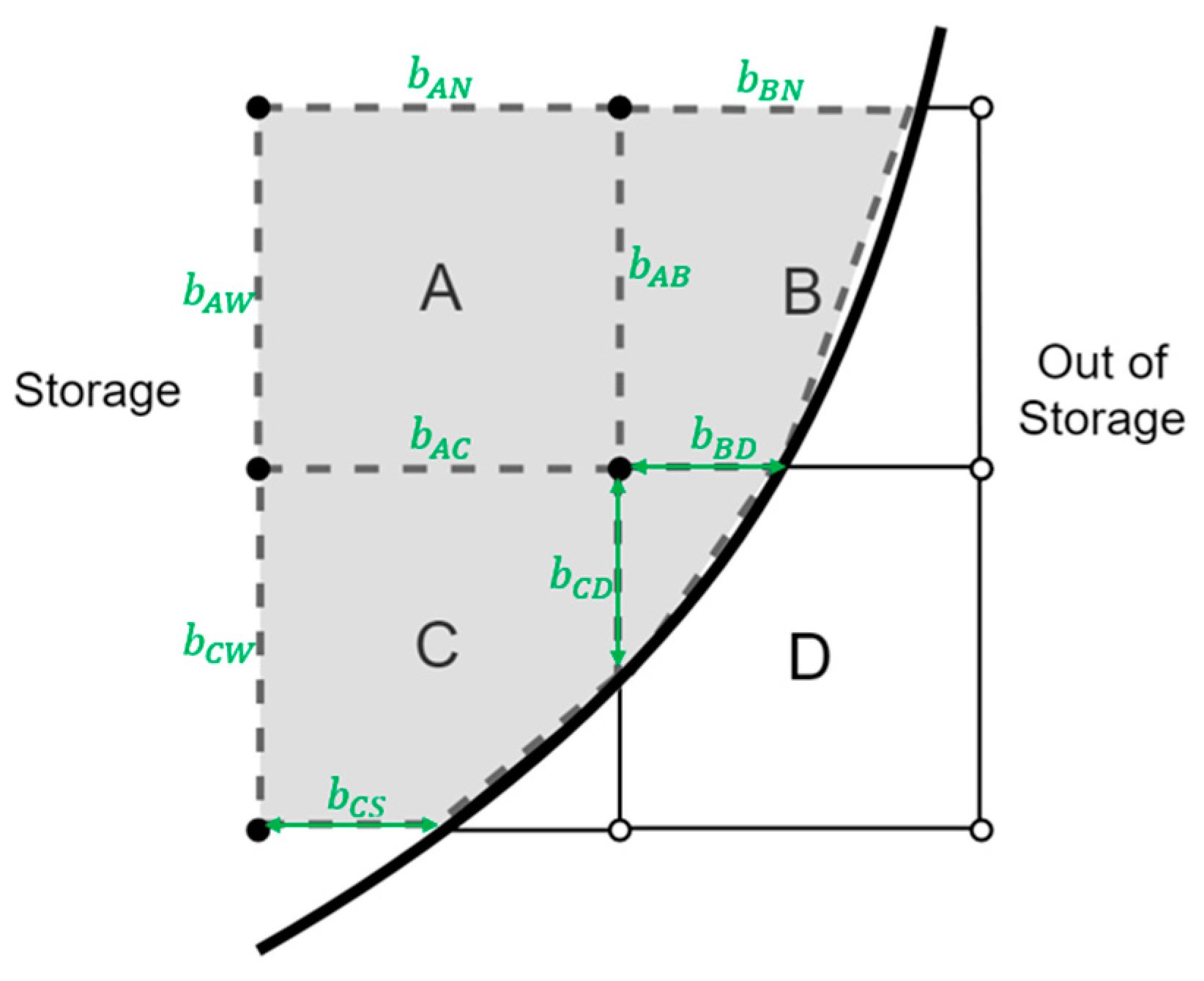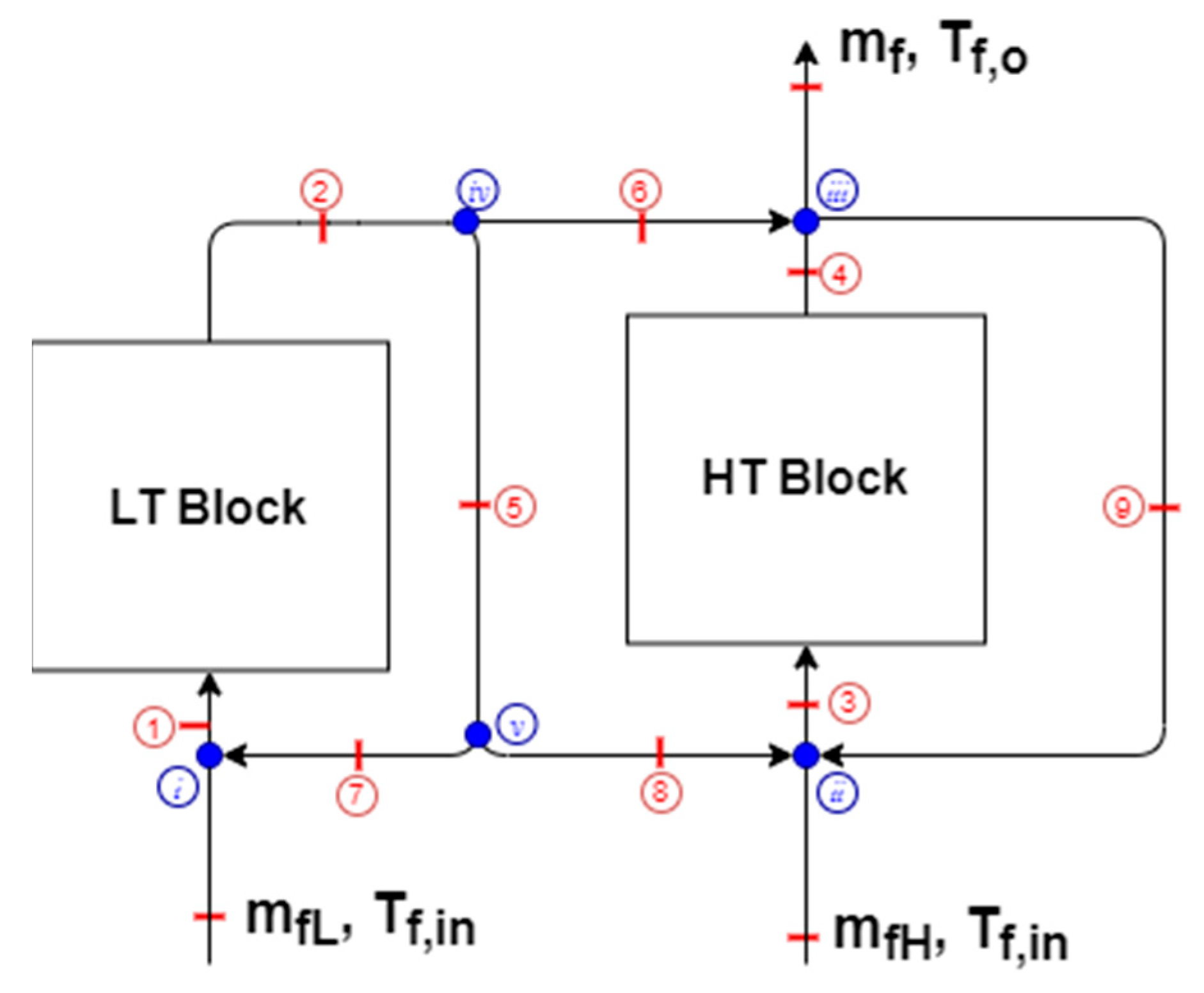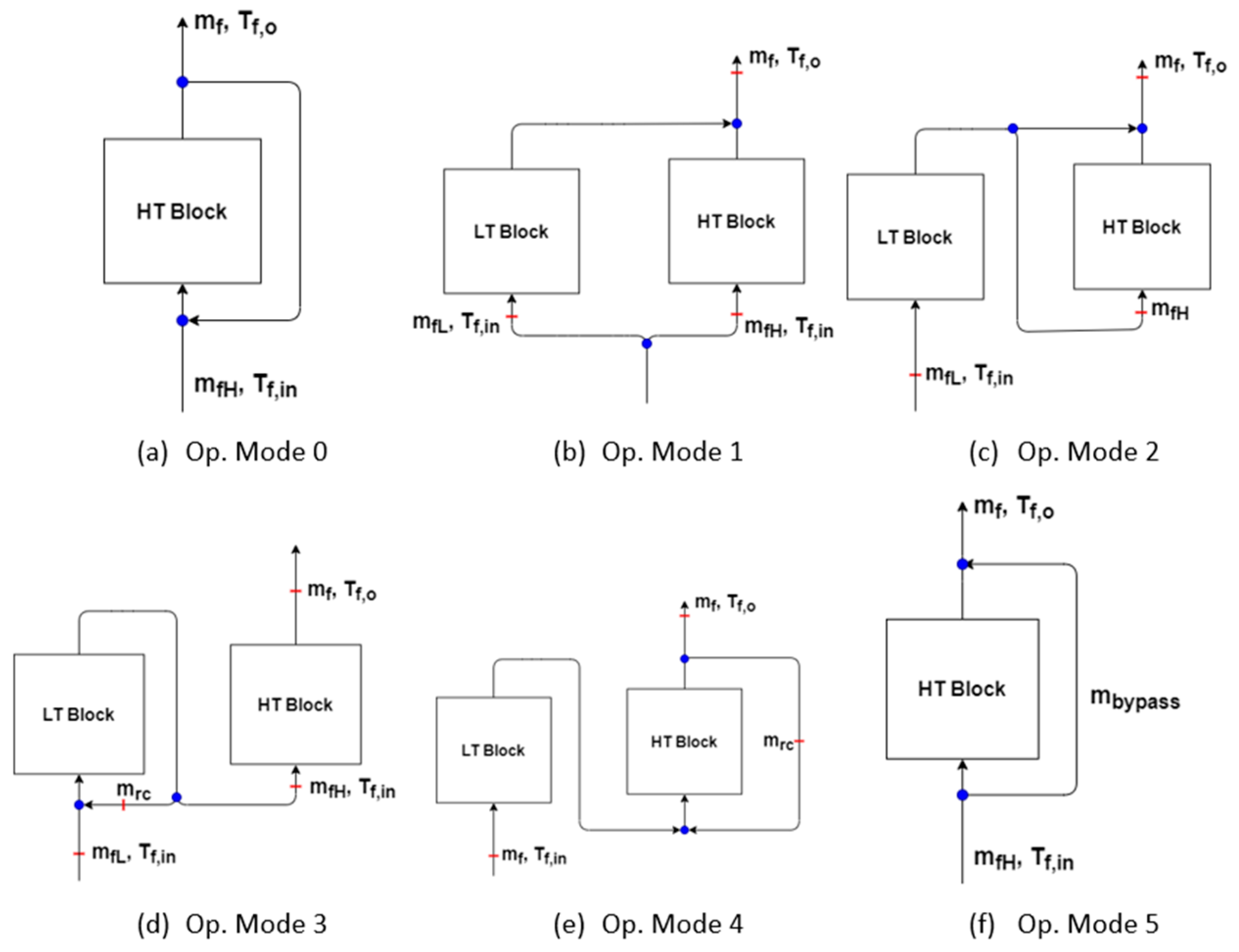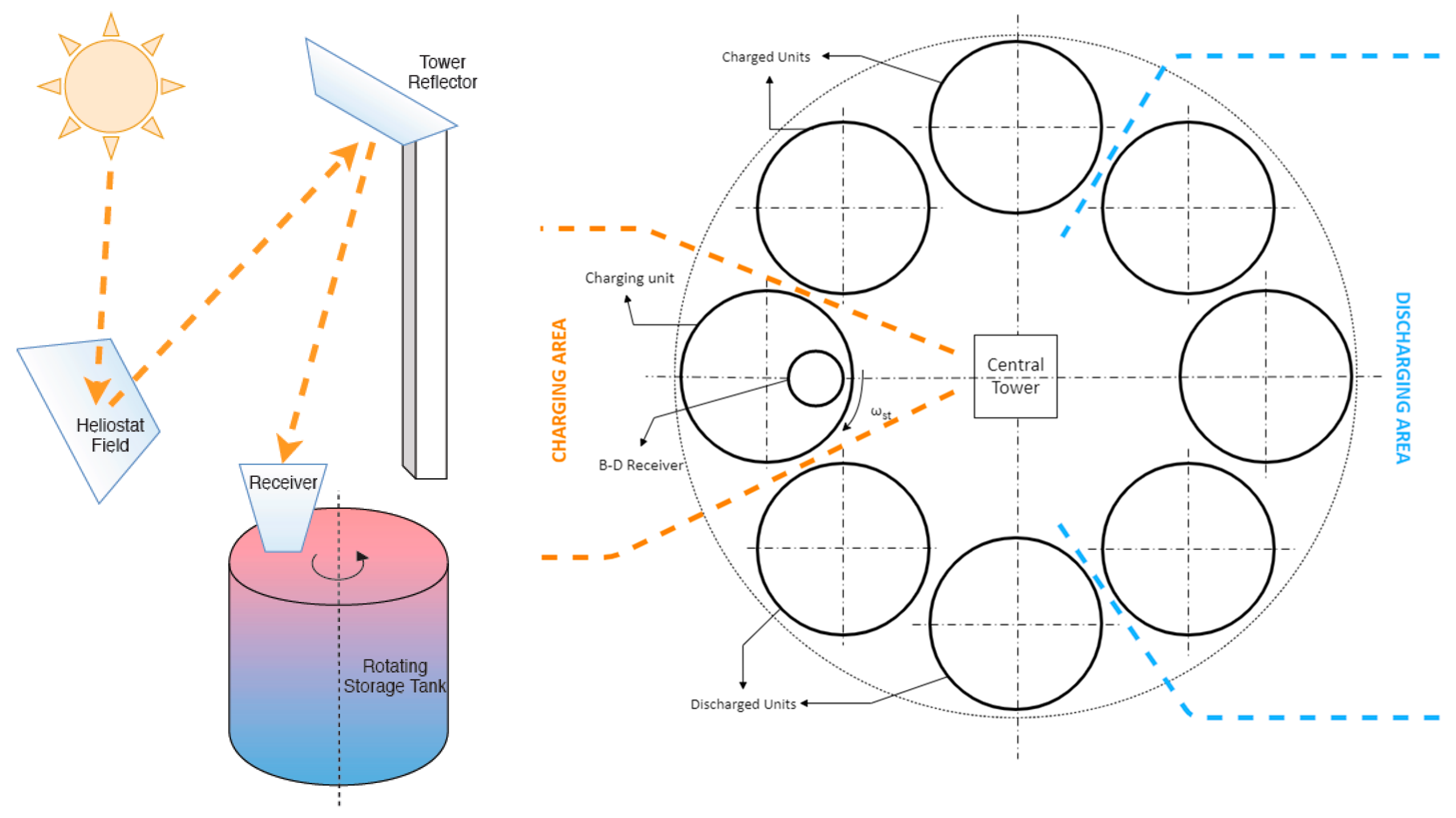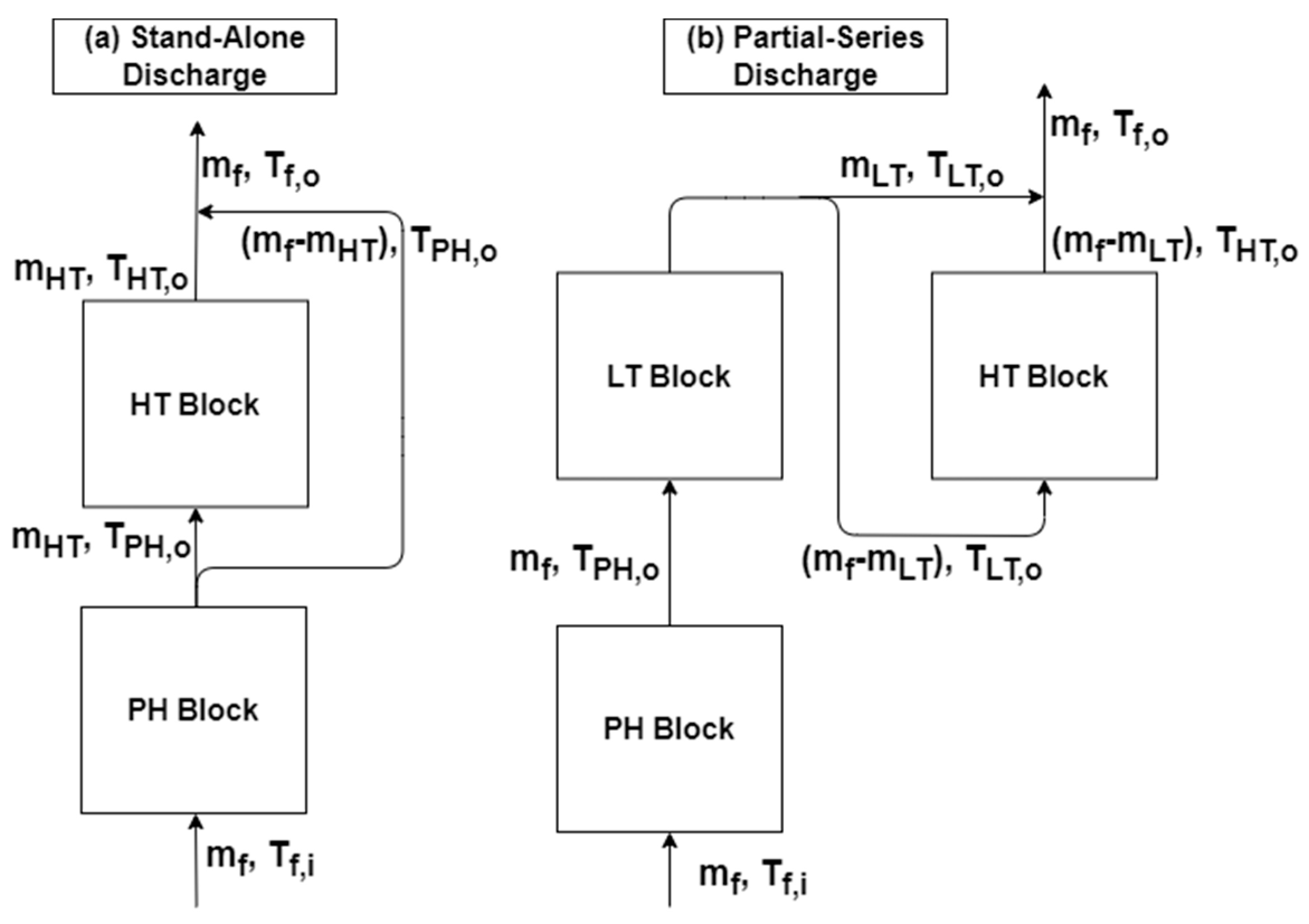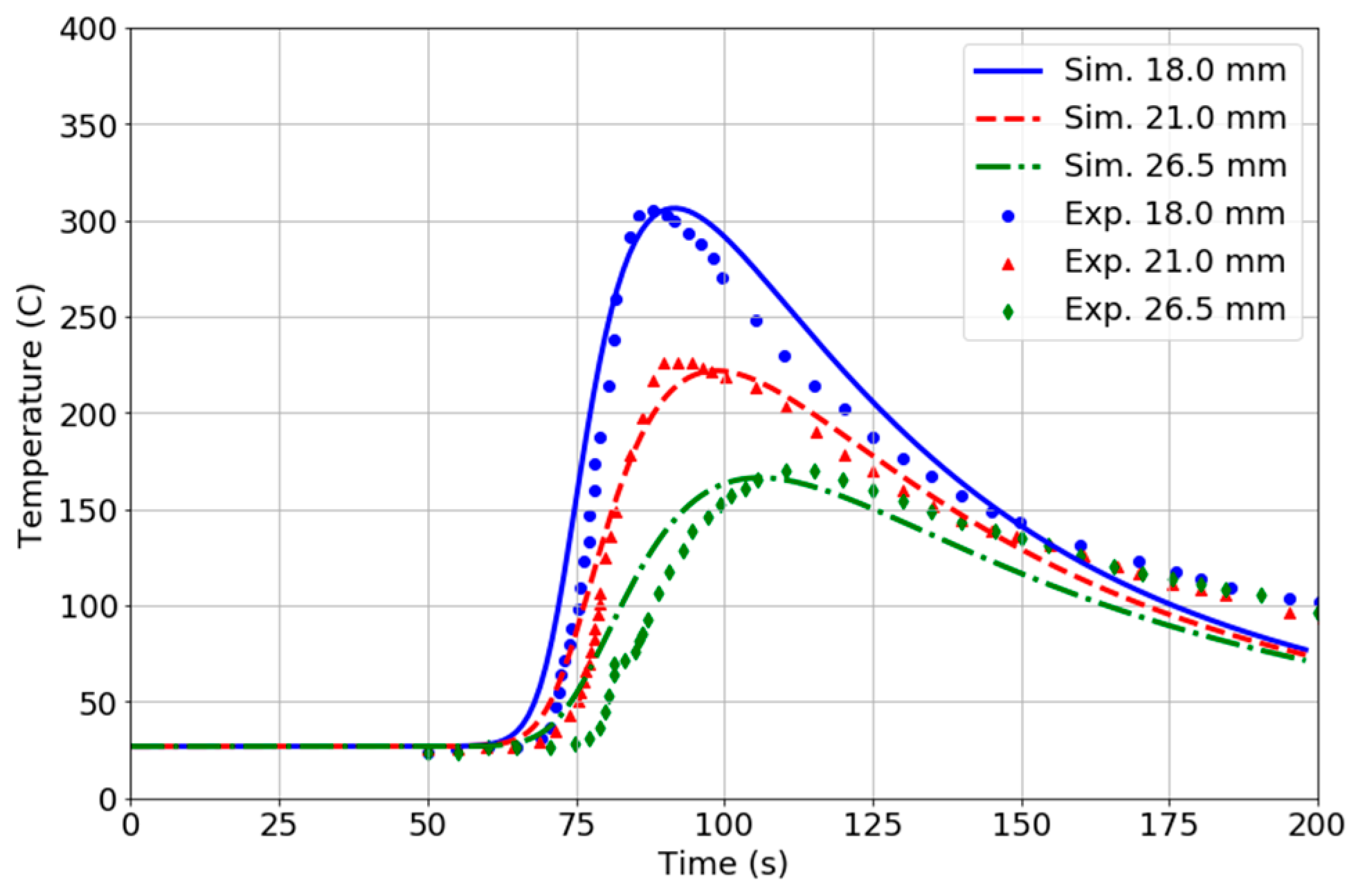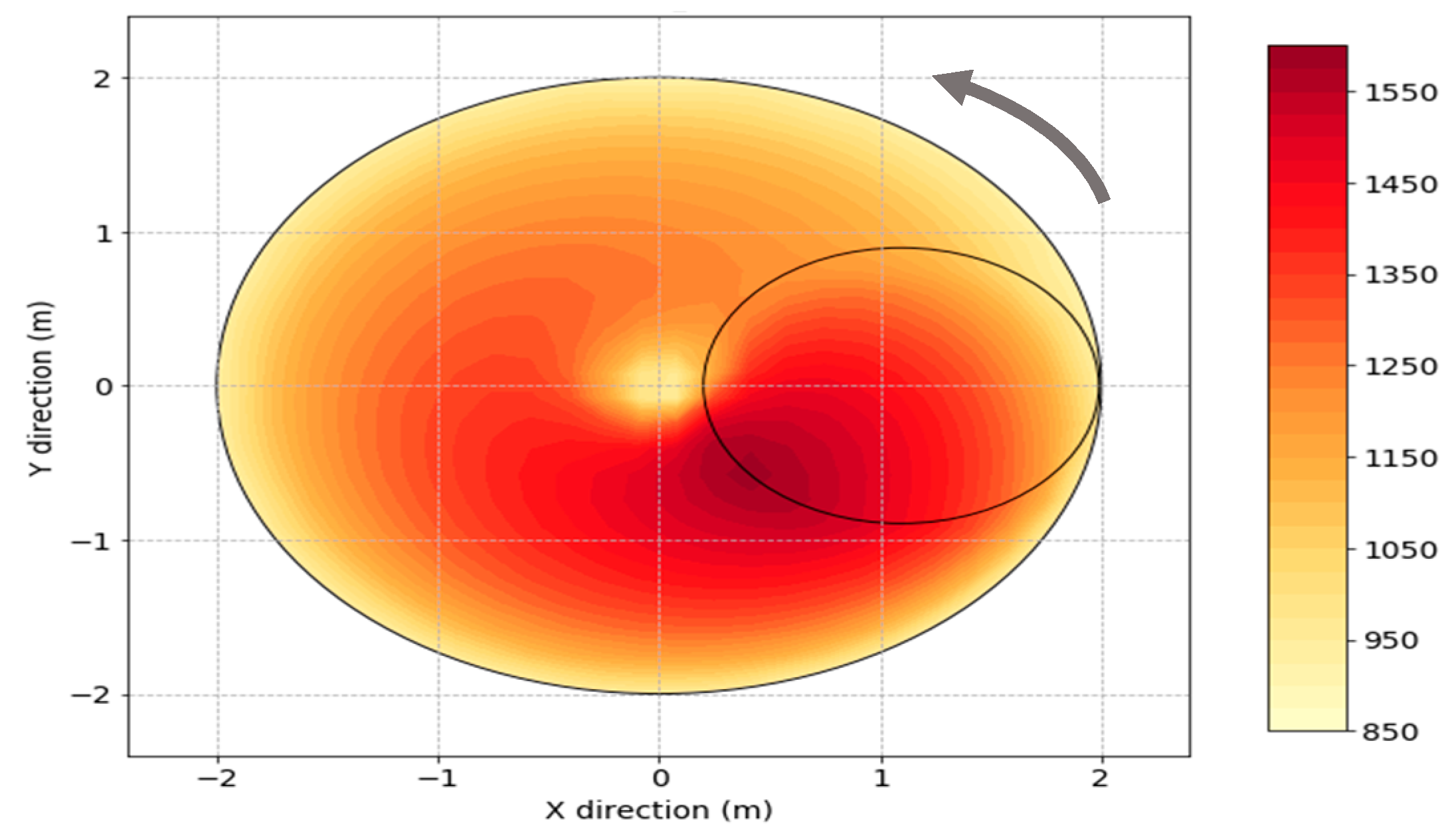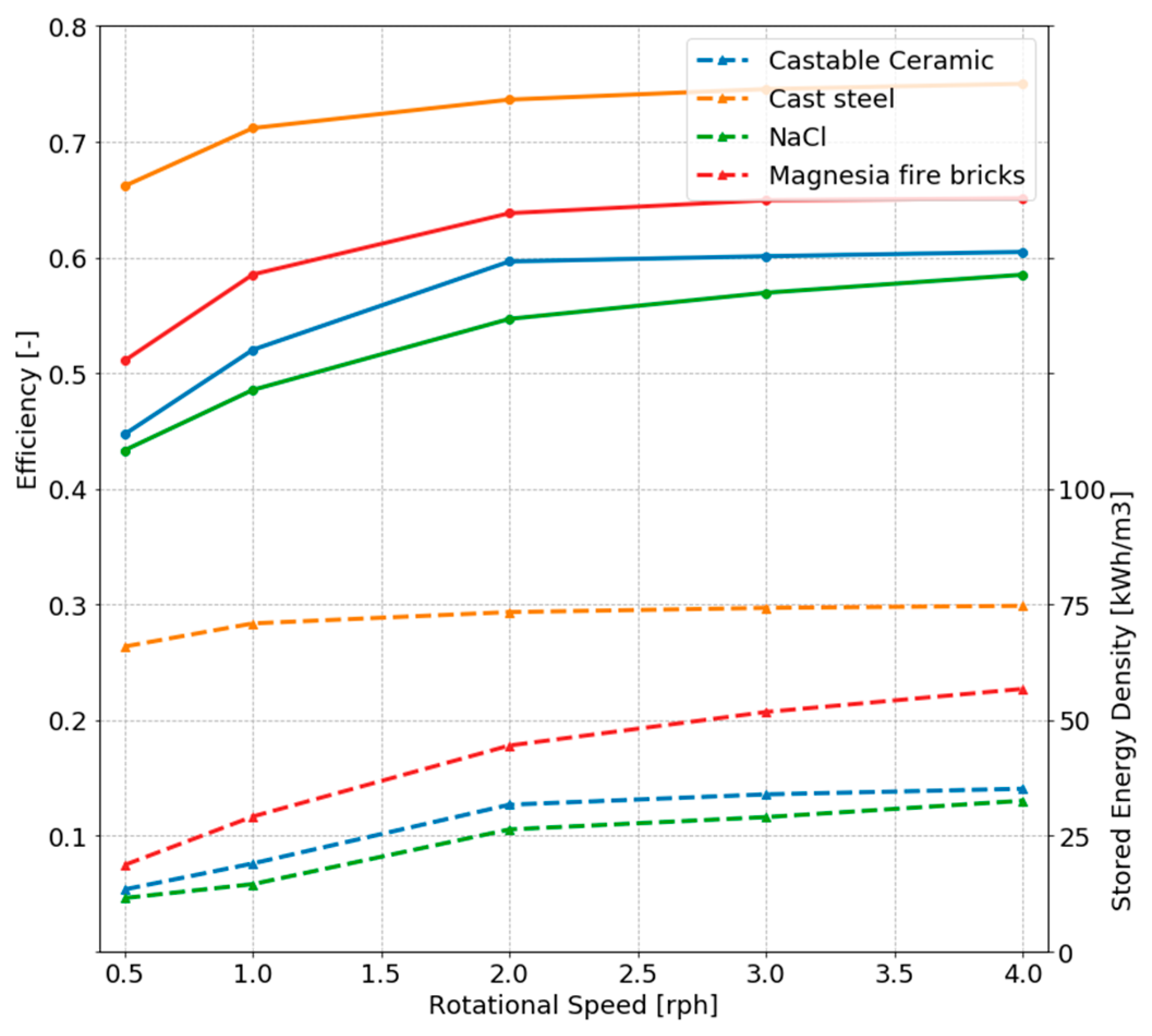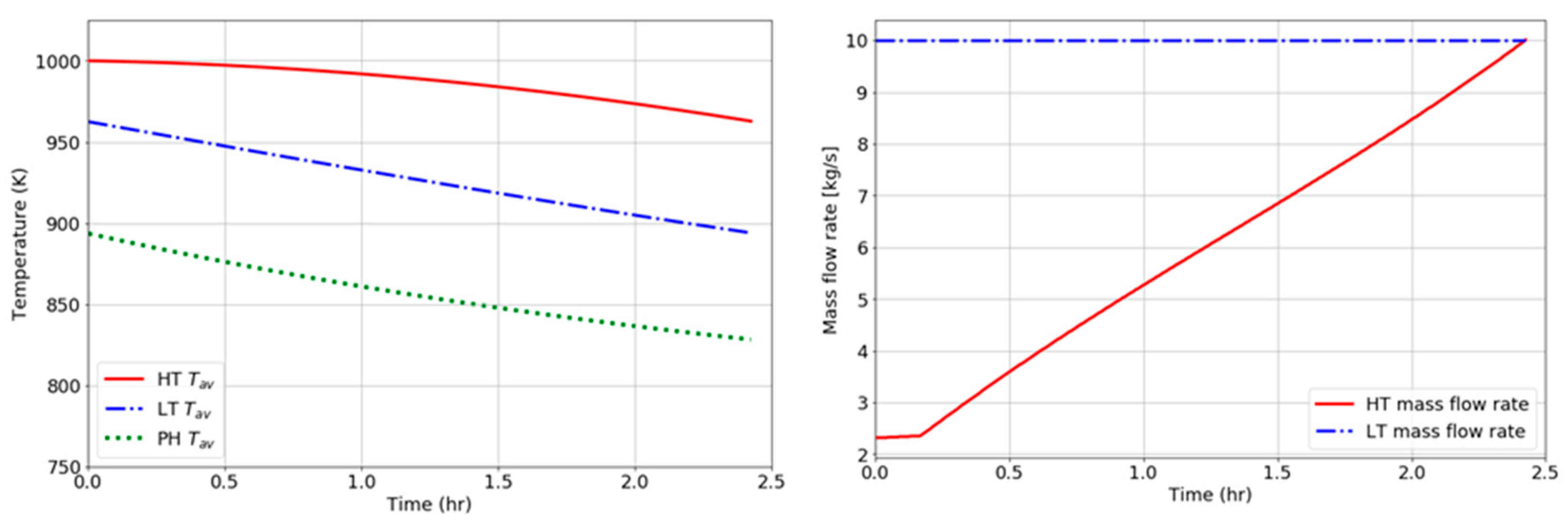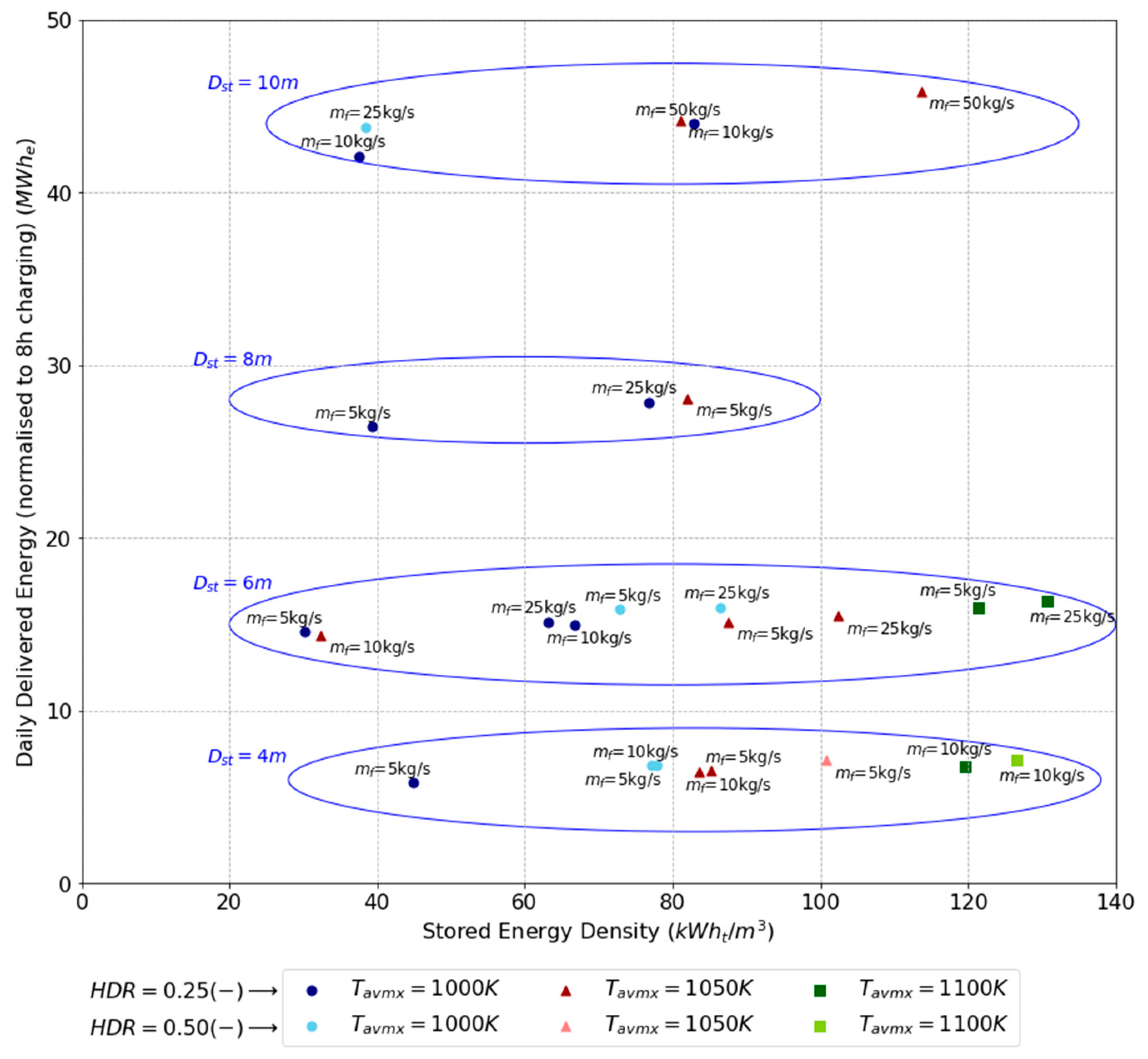1. Introduction
Transitioning to an economy powered by renewables represents the key to mitigating the impacts of climate change and achieving the United Nations’ Sustainable Development Goals [
1]. Concentrated solar thermal (CST) electricity generation plants are expected to play a vital role in the future sustainable energy portfolio due to their inherent capacity to incorporate low-cost thermal energy storage. In this low-carbon emissions future, energy storage is critical to cover the natural intermittencies of renewable resources and shift generation to peaking periods [
2]. Nowadays, CST plants have a higher levelized cost of electricity (LCOE) than other renewables [
3,
4]. One way to reduce LCOE in CST plants is by transitioning towards higher temperatures and correspondingly higher thermal efficiency cycles, which would require replacing conventional CST heat transfer mediums (synthetic oils and molten salts), which are constrained to relatively low temperatures (i.e., below 600 °C) [
5,
6]. Numerous solid mediums are available without such temperature limitations, but the few proposed designs (e.g., volumetric and falling particle receivers) have had limited success in the market [
7]. As an alternative—and potentially simpler and more efficient—option, this paper investigates an innovative modular concept of bringing concentrated light down onto a rotating solid medium. Although this concept introduces some engineering challenges, bringing the light directly onto the storage medium essentially bypasses the use of a liquid working fluid (i.e., no solar loop) and can be designed to allow the high-temperature gaseous working fluid for the power cycle (i.e., pressurized sCO
2) to extract heat directly from the receiver–storage module to increase the overall efficiency of the CSP plant.
Beam-down receivers (BDRs) work by redirecting the radiation onto the ground, where the final receiver is located. This is accomplished by a secondary reflector that is located at the top of the tower, where the conventional receiver would have been originally located. Although this idea was proposed in the seventies and eighties [
8], the seminal works in this technology were developed in the early 2000s, when the optics, possible applications, and proof-of-concept tests were carried out by Segal and Epstein [
9,
10,
11]. They compared two secondary reflectors: an ellipsoid (concave) and a hyperboloid (convex), concluding that the hyperboloid provides the best performance. In theory, BDRs can achieve higher concentration ratios and correspondingly higher thermal efficiencies in the ground-mounted thermal receiver. The main benefits of BDRs are their simpler structure, lower parasitic consumption, and lower impact of wind-associated losses (advective and convective). However, their main drawback is their lower overall optical efficiency due to additional optical devices. Additionally, the same authors found that adding a tertiary (CPC) receiver can increase the overall optical efficiency; however, they also showed how a BDR geometry has an upper bound on the size of the plant since it limits the thermal power up to ~50 MW
th [
10].
Several experimental facilities have tested the beam-down receiver (BDR) concept. The first experimental facility built with this concept was developed by the Weizmann Institute of Science in Israel [
11] in 1999. The plant has a nominal capacity of 0.7 MW
th with a 75 m
2 hyperboloid mirror and a 2.2 m-aperture diameter CPC. On other hand, the Masdar Institute built and tested a beam-down facility in the UAE since 2011 [
12]. This unit, called CSPonD (concentrated solar power on demand demonstration), includes 280.7 m
2 of heliostats and is designed for a nominal heat input of 100 kW
th with a concentration ratio of up to 600 and an optical efficiency of up to 77% [
13]. In an additional stage, a 600 kWh molten salt storage tank was incorporated [
13,
14], with an overall thermal performance in the range of 24–28% (using an idealized Carnot cycle) [
15]. A scale-up analysis predicts a LCOE of ~0.1 USD/kWh for a plant of 50 MW
e [
16]. Finally, the University of Miyazaki (Japan), developed another BDR facility in 2012, which also has a 100 kW
th nominal power output and a 176 m
2 primary collection area. The main difference between this system and the previous ones is that it uses an ellipsoid mirror, and its purpose is thermochemical water splitting [
17].
On the other hand, a couple of commercial plants have been installed. The Italian company Magaldi Industrie installed the first documented commercial plant using beam-down optics. In 2012, a 100 kW
th experimental plant was built in Buccino (Italy) [
18]. Then, in 2016, the company started operating a 2 MW
th plant in S. Filippo Del Mela (Italy) designed to generate 20.5 tons/day of steam [
19]. The system uses a four-facet hyperboloid or flat mirror as a secondary reflector, 786 heliostats of 7 m
2 each, heating a 270-ton sand tank of 8.2 MWh of thermal capacity. The Yumen Xinneng, Xinchen, in, China, is the only commercial plant currently in operation. The 50 MW
e plant is a multi-tower plant that opened its first unit in 2021 and consists of 5 towers that are 70 m each and heat molten salt [
20]. The plant has nine hours of storage capacity to drive a conventional steam cycle with dry cooling. The solar field has 208240 m
2 of mirror area installed on a site with a total area of 3.69 km
2. Finally, a second beam-down CSP project is under construction in Akesai Jiuquan, China [
21]. The project, called Huidong New Energy Akesai, is a hybrid 110 MW CSP + 640 MW PV and is part of the massive portfolio of hybrid projects currently under construction in China. It consists of a conventional steam cycle with 8 h of molten salt thermal storage. It is expected to be operational by the end of 2023 [
21].
Despite this continued interest in the beam-down receiver, there has been little investigation into how a beam-down receiver could incorporate solid storage materials. In one example, a numerical simulation of a dual beam-down receiver–storage unit with conductive rods in a sand-basalt mixture has been shown to reach a utilisation ratio of up to 73% [
22]. In addition, a gravity-fed receiver concept for sand particles was proposed by Iniesta et al. [
23] and tested experimentally, which reached up to 900 °C for a 2 kW BDR. However, the agglomeration of the particles at operation temperatures above 600 °C created a reliability issue for this type of sand. Finally, a beam-down Fresnel-like linear receiver was proposed by Gómez-González et al. [
24] in 2018. To date, although the BDR represents a straightforward design that is capable of reaching high concentration ratios, the literature on beam-down receivers has mostly been dedicated to either the optics or their use for conventional heat transfer mediums (such as molten salts). Therefore, the high temperature potential of BDRs (e.g., via solid materials) has not been explored in detail.
The proposed system considers a directly irradiated receiver–storage device that absorbs and stores solar energy simultaneously. Since the receiver is located on the ground and contains a lot of thermal mass, it requires beam-down optics to deliver concentrated radiation to the absorber surface. The thermal transport subsystem is simplified with this concept (relative to a volumetric air receiver or a falling particle receiver), which enables a reduction in parasitic pumping power consumption and in the exergetic losses associated with transferring heat between separate receiver and storage components. The proposed design uses a simple, solid cylindrical unit that is insulated on all sides except for a small window on the top that receives concentrated irradiance, as shown in
Figure 1 (left). Candidate materials for the cylinder include concrete, cast steel, magnesia fire bricks, ceramics, etc.
The main difference with this design over a traditional high-temperature sensible thermal storage unit is that charging relies upon radiation (and subsequent conduction) rather than convective heat transfer with a circulating heat transfer fluid. Thus, even more so than a shell-tube sensible storage unit, this design depends on the thermal conductivity of the material. Low thermal conductivity would result in high stratification in the storage unit and, consequently, low storage effectiveness (e.g., only a small proportion of total storage capacity can be effectively used). In addition, low thermal conductivity would result in hotspots at the focal spot of the receiver, which would induce higher radiative losses.
To distribute the heat, we considered the use of conductive rods and a recirculating gas but settled on a novel alternative: rotating the spot relative to the storage tank. That is, as shown in
Figure 1, if the solar focal spot is not concentrically located with the central axis of the cylinder, then the heat can be spread in the theta direction by slowly rotating the focal spot relative to the storage unit (or by manually rotating the cylinder relative to a fixed focal spot). This should reduce heat losses, increase efficiency, and promote a more homogeneous charging process.
Clearly, the geometry of this type of storage unit critically affects the effectiveness and temperature distribution during charging/discharging. To obtain a good balance between storage volume (total storage capacity) and charging effectiveness (usage of the stored energy), which are inversely related, multiple modular storage cylinders can be used to obtain the desired capacity. As shown in
Figure 1 (right), once one unit is charged, the following unit can be rotated in as the active receiver. This modular concept also serves as a form of control to ensure optimal charging and avoid overheating zones. Moreover, the modular design allows heat extraction from the modules to occur in series and/or parallel with the charging process to better match the solar resource.
As was alluded to previously, it is envisioned that this storage system would drive a high-temperature supercritical CO
2 Brayton cycle. Therefore, the heat extraction will require supercritical CO
2 fluid to pass through a piping array inside the storage unit. One of the challenges for the discharging process of a solid storage medium is to ensure a stable fluid mass flow rate and temperature output for the cycle when the sensible storage unit’s temperature is decreasing over time. A stable temperature and mass flow rate output from the storage system are some of the biggest advantages of the conventional two-tank configuration. The proposed system will be compared with that conventional configuration. In order to reach that feature, several possible configurations are explored. The discharging process can also be done in series or in parallel to precisely control the inlet conditions in advanced power cycles, with no need for thermal stratification since each module would naturally be at different states of charge (e.g., average temperature). Two operation modes are proposed after testing different alternatives. A general setup for the different configurations between two tanks was developed and can be checked in the
Appendix B. With the proposed modular design, two different operation modes, which are shown in
Figure 2, are proposed to extract thermal energy:
- (a)
Stand-alone operation of one cylinder. If one storage cylinder can provide the desired extracted energy, then it can operate independently. In this case, only a fraction of the total mass flow rate would circulate inside this cylinder, while the remaining fraction would be mixed with the hotter stream. Over time, the fraction increases until all the flow goes through this cylinder. At this point, it is necessary to change the operation mode because the cylinder is unable to provide the desired output.
- (b)
Partial-series flow between low-temperature (LT) and high-temperature (HT) cylinders. In this strategy, the whole flow passes first through one unit, the low-temperature (LT) cylinder. As required, a fraction of this flow is diverted to subsequently circulate through a high-temperature (HT) cylinder to obtain a high enough temperature that when the two flows are remixed at the outlet manifold, they provide the required CO2 Brayton cycle inlet temperature (and flow rate). During this process, the temperature of both cylinders decreases, so a gradually higher flow fraction must be diverted into the HT cylinder. The process finishes when all the flow circulates in a series mode, which means no more energy can be extracted from this layout. After that, a new HT cylinder is required, and the previous HT cylinder can become the LT cylinder.
It should be noted that several additional strategies were considered for this design, but these were found to provide the best results and were the most easily controlled. For example, using parallel flow between two cylinders and adjusting the splitting fraction could also be used to ensure a constant output temperature and flow. However, the above mode (b) would extract the most possible energy from the LT cylinder because the total mass flow rate always circulates through this cylinder, giving it the most time/opportunity to discharge. This enables higher energy extraction, more operation time, and a higher stored energy density in each cylinder. Thus, the discharge process strategy in the present work will consist of operation mode (a) when possible, followed by operation mode (b).
It should be noted that several additional strategies were considered for this design, but these were found to provide the best results and were the most easily controlled. A detailed discussion of the general setup and the different possible configurations is given in the
Appendix B. For example, using parallel flow between two cylinders and adjusting the splitting fraction could also be used to ensure a constant output temperature and flow. However, the above mode (b) would extract the most possible energy from the LT cylinder because the total mass flow rate always circulates through this cylinder, giving it the most time/opportunity to discharge. This enables higher energy extraction, more operation time, and a higher stored energy density in each cylinder. Thus, the discharge process strategy in the present work will consist of operation mode (a) when possible, followed by operation mode (b).
In addition, to increase the overall temperature difference, a third storage cylinder can be used as a preheater (PH). A preheater can operate in the same way as the low and high temperature units but requires a lower temperature level. The use of a PH unit produces a cascade effect, which allows a more efficient charging process because PH and LT units work at lower temperatures than HT. These operation modes are presented schematically in
Figure 2. Consequently, mode (b) requires at least three storage units: a preheater (PH), a low-temperature (LT) cylinder, and a high-temperature (HT) cylinder. This operation mode will be analyzed in detail in the overall plant analysis section.
2. Materials and Methods
To test and analyze this receiver–storage concept, a numerical model was built. The numerical model was based on heat transfer equations for conduction, convection, and radiation. The storage system assumes the two different processes occur independently: (1) rotational charging from a concentrated solar flux and (2) discharging via conduction and convection to a flowing supercritical CO2 fluid.
2.1. Charging Process
For the charging process, the storage unit was assumed to be a solid cylinder. Therefore, inside the volume of the unit, conduction represents the only heat transfer mechanism. In order to ensure that this assumption is acceptable, a design constraint was introduced (see Equation (24)) to ensure the volume occupied by internal piping (needed for the discharging) was limited to less than 10% of the total volume. To simulate this, the energy conservation equation was used in its differential three-dimensional transient form, assuming constant thermophysical properties:
where
is the storage material temperature,
is the thermal diffusivity of the material,
and
are the horizontal coordinates,
is the vertical coordinate, and
represents the temporal variable. At first glance, a Cartesian coordinate system seems more complicated than cylindrical coordinates for a cylindrical block. However, Cartesian coordinates have the same element sizes throughout the volume and are useful for the implementation of the boundary conditions of this problem. Equation (1) can be numerically solved using a finite volume method for spatial discretisation and the fully implicit scheme for temporal discretisation. For each discrete (non-boundary) element, the governing numerical equation can be written as:
where
, for
, and
is the temporal step. This is valid for
,
, and
.
The cylinder’s outer boundary was assumed to be well-insulated, so adiabatic boundaries were employed on the bottom and around the outside surface of the cylinder. For the top surface, an adiabatic boundary was also applied, with the exception of the receiver window area, which was matched to the focal spot diameter, which transmits the incident light.
A Cartesian coordinate system was used, so it was necessary to identify the elements of storage belonging to the curved surface of the cylinder. To handle this, a function (
) was defined to evaluate if the elements belong (
) or do not (
) to the storage unit. For most boundary elements,
takes a fractional value. A brief explanation of this function is presented in
Appendix A. A similar function (
) was used to define the elements under the receiver.
For the elements exposed to concentrated radiation, Equation (2) is not valid because the external energy input and heat losses must be considered. For these receiver elements (
), the energy equation becomes:
where
and
, are the incident solar flux and the heat losses for element
. For elements under the receiver, the inlet flux of energy can be calculated from Equation (4).
where
is concentrated solar radiation in the beam-down receiver (in
),
is the transmittance of the quartz receiver,
is the absorptance of the storage medium, and
is the surface area of the element. In order to ensure simplicity, the solar flux was considered to be uniformly distributed.
The proposed design includes a quartz cover to reduce heat losses, which was considered in the numerical model as only one element. The heat losses were calculated considering convection and radiation heat transfer between the surface elements and the quartz cover. The heat loss flux, a combined convection–radiation coefficient, and the linearized radiation coefficient are presented in Equations (5)–(7).
The convective heat transfer between the cylinder’s surface and the quartz was calculated by assuming an air gap at atmospheric pressure via correlations for natural convection between horizontal plates [
25]:
For the heat transfer between the quartz cover and the environment, both convective and radiative heat transfer must be considered. In this case, the radiative heat transfer is between the quartz cover and the sky, while the convective heat transfer is between the quartz cover and the surroundings (e.g., the ambient air temperature). In addition, the natural convection correlation for the horizontal flat plate was used to define
hc,g-amb.
2.2. Discharging Process
The discharging process considers the heat transfer between the supercritical fluid and the wall of the tube array, located inside the storage cylinder. The model assumes that each tube has the same mass flow rate, which extracts thermal energy from the surrounding volume of storage material. In addition, it was assumed that when the storage material reached a thermodynamic equilibrium, there would only be conduction in the vertical direction because the discharge process would extract energy first from the bottom part of the cylinder. In order to take this phenomenon into consideration, the cylinder was discretised vertically, and each element of the storage was assumed to be lumped system (e.g., each element has a uniform temperature).
The equations that represent this phenomenon are:
where subscripts
,
,
,
represent flow, storage, inlet, and outlet, respectively.
represents the convective area, with
as pipe diameter and
as the vertical discretisation. Subscript
k in Equation (12) represents the element in the vertical discretisation in these equations as well.
is the convective heat transfer. Replacing
with the right-hand-side of Equation (14) in both Equations (12) and (13) and considering a linear temperature increase in the flow side
results in an implicit system valid for
, which can be represented as follows:
where
is the timestep,
, and
. The convective heat transfer coefficient is calculated using the well-known Gnielinski correlation for transition and turbulent flow [
26] and a developing flow correlation for laminar flow developed by Kakaç et al. [
26]:
where
and
are the Peclet and Reynolds numbers for circular pipes, and
is the Darcy friction factor, calculated with the Haaland approximation of the Colebrook–White equation [
26]. All the properties for sCO
2 were calculated using the Cantera module for Python [
27]. This model also uses the lumped approximation for each element, neglecting the conduction inside the storage section. This approximation is valid for
, which is not met by typical solid storage materials. To fix this issue, Xu et al. [
28] proposed an extension of the lumped method that defined an equivalent heat transfer coefficient,
, that takes into account both convection and internal conduction. For storage material with fluid flowing inside a tube, the Xu et al. method for equivalent HTC is:
Here,
and
for the present system.
and
are the diameter and number of pipes inside the storage cylinder. This correction reduces the effective heat transfer coefficient, and it depends strongly on the storage material’s thermal conductivity. As an example, for
and the geometry used in the discussion (
Section 3.1), the correction ranges from a 3.2% reduction for cast steel (i.e.,
at the highest thermal conductivity tested) to 48.2% (i.e.,
at the lowest thermal conductivity tested).
During the discharge process, the two cylinders will operate in the “partial-series” operation mode (b) described above. Thus, the discharge output will be the combination of the flows from both the HT and the LT cylinders, which can be determined mathematically with:
Note that for each timestep, the proportion will be changed to ensure a desired .
2.3. Non-Dimensional and Performance Parameters
The model is designed to work with different storage unit volumes, solar field sizes, and power block capacities. In order to simulate this system over a broad range and achieve meaningful results, several non-dimensional parameters were defined via normalizing based on geometry. To define the receiver size for a given storage volume, a receiver-to-storage surface ratio () was defined, which provides the ratio between the receiver area and the transversal storage area. In addition, the height-to-diameter ratio for the storage cylinder was used (), along with the eccentricity receiver ratio (), a parameter that defines how far off centre the irradiance spot is located. Further, the ratio of unused storage, , was defined as the proportion of storage volume that is occupied by the pipe bundle. For the purpose of this work, this ratio was limited to . So, for a given pipe diameter (), with set, it is possible to define the number of pipes inside each unit.
These parameters are expected to impose geometric limitations on the system’s performance. For example, the receiver radius is fixed for a given receiver capacity. Then a large storage diameter (i.e., a low ) would mean a smaller fraction of storage volume is used. This means the energy density would decrease, and the charging time would increase. Following similar arguments, and would impact charging and discharging times, respectively, imposing additional constraints.
On the other hand, five performance parameters were used to assess the storage behaviour. The receiver–storage efficiency () was calculated as the ratio between input energy and stored energy (Equation (25)). The stored energy density () was defined as volume-specific stored energy (Equation (26) below). The solar multiple () was calculated as the ratio between solar field capacity and the power cycle’s nominal capacity (Equation (27) below), while the time ratio () is a parameter that relates the charging and discharging times (see Equation (28) below). Lastly, the daily delivered energy () is defined as the energy that can be dispatched by the power plant considering both the time of discharge and the nominal power capacity of the plant (Equation (29)).
In these equations, is the total number of elements in spatial discretisation, is the initial storage temperature, is the average storage temperature, represents the direct normal beam irradiance and the concentration ratio, respectively. is the solar field area, which was calculated for a given ().
2.4. Validation
The charging process model cannot be validated directly for high temperature ‘on-sun’ desired conditions since this is a new design. Thus, validation was done for a situation in which a similar phenomenon exists. In this case, the process of stir welding was used, which includes several common characteristics with the current process: a moving heat (circular spot) source over a horizontal surface, conductive heat transfer inside the medium, and natural convective and radiative losses at high temperatures in a horizontal face-up surface. Zhu and Chao [
29] have modelled and experimentally tested a friction stir welding process using 304L steel. The steel plates have dimensions of
, the pin tool is
of diameter, and it moves at
with a thermal power input of
. Three thermocouples were located in the middle of the length plate at different distances from the longitudinal axis (e.g., at 18 mm, 21 mm, and 26.5 mm).
Figure 3 shows the temperature profiles over time between Zhou’s experimental testing and our simulation. The results are in good agreement in terms of both the heating rate (slope) and the maximum temperatures.
2.5. Discretisation Test
A discretisation test was conducted to determine the number of elements needed to attain model independence with respect to temporal and spatial discretisation. For this simulation, the number of elements varied from 10 elements per side (
in total) to 200 per side (
in total), while four temporal steps were considered: 360 s, 120 s, 60 s, and 30 s.
Figure 4 shows efficiency as a function of spatial and temporal discretisation. For temporal discretisation lower than 60 s, there is almost no difference, whilst for spatial discretisation, the elements quickly converge above 50,000 elements.
4. Discussion
In this section, a design process is discussed. The objective is to maximize both the daily average generated energy and the specific energy density. The relationship between the power block size and storage capacity is a key parameter in this regard. Clearly, an increase in storage size would result in an increase in the discharge time and/or the power block capacity. However, it is not possible to indefinitely increase the size of storage cylinders in this design, nor is it possible for a beam-down receiver to increase the size of a solar field beyond a certain area (e.g., the ~50 MW
th limit for a BDR system defined by [
10]). The capacity of the power cycle is defined by the mass flow rate (at constant temperature), while the size and number of storage units determine the storage capacity and required solar field size.
The storage unit was assessed in the operation of a typical CST plant using a sCO
2 Brayton power plant with the conditions defined in the previous section. To analyse this in detail, multi-factorial simulations were run to obtain the performance parameters of the coupled system. The variables considered are sCO
2 mass flow rates (
) (from the power block side), storage unit diameter (
), height-to-diameter ratio (
), and maximum storage average temperature (
). The solar field size was determined by the storage diameter and the receiver-storage surface ratio (
) via Equations (21) and (27). The number of storage units was set at three, working as indicated in
Section 2.2. This configuration represents the minimal system, but the simulations would be similar to the situation in which additional storage units are incorporated until a nominal day (8 h) of charging is achieved. Additionally, the maximum temperature allowed at any point in the storage material is set to
to stay below the melting point of cast steel. It was assumed that before starting the charging or discharging processes, the cylinders had been in a standby state long enough to reach thermal equilibrium.
Table 4 shows the different parameter values considered in simulations in which a total of 150 conditions were simulated.
The mass flow rate was limited to because, with a higher mass flow rate, the discharge time is considerably shorter than the charging time for any condition tested. In addition, the maximum average temperature was limited to because it is not possible to charge the units to higher temperatures without surpassing the maximum temperature limit of the material (recall ~1800 K for cast steel). The two main parameters of interest are the energy released by the power block (, see Equation (29)) and the stored energy density (, see Equation (26)). The first one indicates the amount of energy the system can deliver (and therefore sell), while the last one indicates the amount of material required to store that energy (which is directly related to the capital cost of the storage system).
It should be noted that not all the simulations produce useful results. For all the results in which the discharge process did not occur (i.e., the storage unit was not able to deliver the required output) or if it was too fast (less than 1 h), those results were filtered out. The same was done when the charging process was longer than a nominal day (8 h) or the discharge process was longer than a whole day (24 h). In addition, it was expected that the discharging time would be longer or on the same order as the charging time, so only the results with
were considered. These constraints reduced the simulation set to 26 useful alternatives, presented in
Figure 10, where each point represents a simulated condition. The different average maximum temperatures are represented by different symbols, while the ellipses indicate conditions with the same storage diameter. The other two parameters (mass flow rate and HDH) are indicated in the labels. Due to the fact that the tested conditions have differences in charging times, they are best compared in terms of the delivered energy over 8 h of available charging time.
Broadly speaking, a higher
allows the system to reach higher SED, but its influence on the total energy delivered is not clear. Nevertheless, for
, there were no simulations with delivery energy above
; therefore, a maximum storage temperature of
was allowed. The diameter has a clear and direct influence on the delivered energy. For a
diameter, the energy delivered was around
; for
, it was between
. For
, the energy delivered ranged from
; for
, it varied between
and
. No successful simulations were obtained for the
diameter units. This suggests that
units are the biggest size allowed. The influence of
is related to the diameter. For small storage units (4 m and 6 m), both short (
) and tall (
) units work; however, for larger units (above 6 m), only short units are useful (
), except in one case with low SED. The reason for that is, for larger units, the charging process cannot heat up the whole unit (i.e., the heat does not transfer via conduction to the bottom of the cylinder fast enough). Finally, the influence of the power block size (defined by mass flow rate) is not clear. A larger power block would deliver more energy but for a shorter period of time; therefore, these two phenomena compensate each other. A plausible value for stored energy density is
. Therefore,
Table 5 presents the detailed results for simulations with
and
. These results suggest that the solar field size is limited by the storage unit size rather than beam-down receiver optics (~5 MW
th here versus 50 MW
th, as noted in previous works [
10]).
5. Conclusions
A novel concept of a dual receiver–storage unit for concentrated solar thermal plants was presented. This idea uses the beam-down receiver to concentrate solar radiation onto the proposed unit, which would be located on the ground. This concept allows direct, the radiative heat of the solid storage medium, eliminating the need for a solar loop with a liquid working fluid. While this does add some optical complexity, it reduces the mechanical complexity of the tower while also reducing pumping parasitic losses and exergy losses due to fewer heat exchanges. In addition, this work presents a clever discharge strategy to ensure a constant input temperature and flow rate from this storage system for a sCO2 power cycle. To achieve this, at least three storage modules were required to work together in a ‘partial-series discharge’ mode.
A numerical model was built and validated that can simulate both charging and discharging processes under different conditions. The charging process analysis showed that high thermal conductivity is indispensable to spreading the concentrated radiation quickly inside each storage unit. Therefore, among the proposed materials, cast steel was selected since it achieved the highest charging efficiency (>70%).
The simulation of these storage units in a CSP plant indicated some constraints about the expected size this configuration can have. Several conditions were tested, exploring different storage sizes and power plant capacities. It was found that there was no viable solution for plants above
and storage units above
in diameter. However, the specific size would depend on the purpose of the plant since multiple smaller towers could be combined into a common power block (as is done in other commercial systems, such as the Vast Solar demonstration facility [
34]). Thus, a single BDR receiver could be envisioned to deliver up to a nominal
of electricity (with up to 9 h of storage), using
of storage and
of solar field to drive a
power plant.
The size limitations found in this work show that BDR is suitable for modular power generation. Additional research should be conducted to study other possible applications where a modular design is also desired, such as industrial processes (SHIP), thermochemical reactions, and desalination. Although the results shown here can be extrapolated to other applications, a specific study for each case should be performed, specifically in the discharge process, using a different HTF. Finally, additional work should be conducted in experimental analysis to further the validation of the existing and techno-economic analyses to optimise the solar field, beam-down optics, and power block sizes.
These conclusions, together with the ability of a sCO
2 turbine to ramp quickly [
35], suggest that this kind of plant could work well as a small solar-peaking plant. The modular nature of this concept could reduce investment risks and would allow multiple levels of dispatch if modules were distributed to stabilise the grid or if they were co-located with large solar PV installations.
